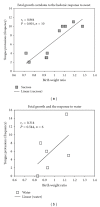Intrauterine growth restriction and the fetal programming of the hedonic response to sweet taste in newborn infants
- PMID: 22851979
- PMCID: PMC3407636
- DOI: 10.1155/2012/657379
Intrauterine growth restriction and the fetal programming of the hedonic response to sweet taste in newborn infants
Abstract
Intrauterine growth restriction is associated with increased risk for adult metabolic syndrome and cardiovascular disease, which seems to be related to altered food preferences in these individuals later in life. In this study, we sought to understand whether intrauterine growth leads to fetal programming of the hedonic responses to sweet. Sixteen 1-day-old preterm infants received 24% sucrose solution or water and the taste reactivity was filmed and analyzed. Spearman correlation demonstrated a positive correlation between fetal growth and the hedonic response to the sweet solution in the first 15 seconds after the offer (r = 0.864, P = 0.001), without correlation when the solution given is water (r = 0.314, P = 0.455). In fact, the more intense the intrauterine growth restriction, the lower the frequency of the hedonic response observed. IUGR is strongly correlated with the hedonic response to a sweet solution in the first day of life in preterm infants. This is the first evidence in humans to demonstrate that the hedonic response to sweet taste is programmed very early during the fetal life by the degree of intrauterine growth. The altered hedonic response at birth and subsequent differential food preference may contribute to the increased risk of obesity and related disorders in adulthood in intrauterine growth-restricted individuals.
Figures
Similar articles
-
Intrauterine growth restriction modifies the hedonic response to sweet taste in newborn pups - Role of the accumbal μ-opioid receptors.Neuroscience. 2016 May 13;322:500-8. doi: 10.1016/j.neuroscience.2016.02.033. Epub 2016 Feb 27. Neuroscience. 2016. PMID: 26926962
-
Taste intensity and hedonic responses to simple beverages in gastrointestinal cancer patients.J Pain Symptom Manage. 2007 Nov;34(5):505-12. doi: 10.1016/j.jpainsymman.2006.12.013. Epub 2007 Jul 5. J Pain Symptom Manage. 2007. PMID: 17616339
-
Increased palatable food intake and response to food cues in intrauterine growth-restricted rats are related to tyrosine hydroxylase content in the orbitofrontal cortex and nucleus accumbens.Behav Brain Res. 2015;287:73-81. doi: 10.1016/j.bbr.2015.03.019. Epub 2015 Mar 18. Behav Brain Res. 2015. PMID: 25796489
-
Intrauterine growth restriction - impact on cardiovascular diseases later in life.Mol Cell Pediatr. 2018 Mar 20;5(1):4. doi: 10.1186/s40348-018-0082-5. Mol Cell Pediatr. 2018. PMID: 29560535 Free PMC article. Review.
-
Intrauterine Growth Restriction: Postnatal Monitoring and Outcomes.Pediatr Clin North Am. 2019 Apr;66(2):403-423. doi: 10.1016/j.pcl.2018.12.009. Pediatr Clin North Am. 2019. PMID: 30819345 Review.
Cited by
-
Associations between biological and behavioral factors in early life and food consumption in Brazilian adolescents: Results from the ERICA study.PLoS One. 2022 Mar 2;17(3):e0264714. doi: 10.1371/journal.pone.0264714. eCollection 2022. PLoS One. 2022. PMID: 35235605 Free PMC article.
-
Birth weight and catch up growth are associated with childhood impulsivity in two independent cohorts.Sci Rep. 2018 Sep 12;8(1):13705. doi: 10.1038/s41598-018-31816-5. Sci Rep. 2018. PMID: 30209275 Free PMC article.
-
Finding the Sweet Spot: Measurement, Modification, and Application of Sweet Hedonics in Humans.Adv Nutr. 2021 Dec 1;12(6):2358-2371. doi: 10.1093/advances/nmab055. Adv Nutr. 2021. PMID: 33957666 Free PMC article.
-
Impact of Early Nutrition, Physical Activity and Sleep on the Fetal Programming of Disease in the Pregnancy: A Narrative Review.Nutrients. 2020 Dec 20;12(12):3900. doi: 10.3390/nu12123900. Nutrients. 2020. PMID: 33419354 Free PMC article. Review.
-
Maternal Protein Restriction in Rats Alters Postnatal Growth and Brain Lipid Sensing in Female Offspring.Nutrients. 2023 Jan 16;15(2):463. doi: 10.3390/nu15020463. Nutrients. 2023. PMID: 36678336 Free PMC article.
References
-
- Hales CN, Barker DJP. Type 2 (non-insulin-dependent) diabetes mellitus: the thrifty phenotype hypothesis. Diabetologia. 1992;35(7):595–601. - PubMed
-
- Forsen T, Eriksson J, Tuomilehto J, Reunanen A, Osmond C, Barker D. The fetal and childhood growth of persons who develop type 2 diabetes. Annals of Internal Medicine. 2000;133(3):176–182. - PubMed
-
- Ravelli ACJ, van der Meulen JHP, Michels RPJ, et al. Glucose tolerance in adults after prenatal exposure to famine. The Lancet. 1998;351(9097):173–177. - PubMed
-
- Ravelli ACJ, van der Meulen JHP, Osmond C, Barker DJP, Bleker OP. Obesity at the age of 50 y in men and women exposed to famine prenatally. American Journal of Clinical Nutrition. 1999;70(5):811–816. - PubMed
-
- Ravelli GP, Stein ZA, Susser MW. Obesity in young men after famine exposure in utero and early infancy. The New England Journal of Medicine. 1976;295(7):349–353. - PubMed
LinkOut - more resources
Full Text Sources


